

| Order-5 cubic honeycomb | |
|---|---|
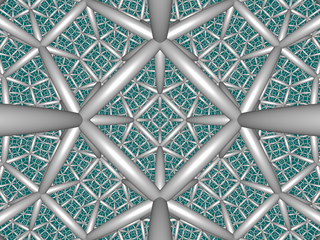 Poincaré disk models | |
| Type | Hyperbolic regular honeycomb Uniform hyperbolic honeycomb |
| Schläfli symbol | {4,3,5} |
| Coxeter diagram | |
| Cells | {4,3} (cube) |
| Faces | {4} (square) |
| Edge figure | {5} (pentagon) |
| Vertex figure |  icosahedron |
| Coxeter group | BH3, [4,3,5] |
| Dual | Order-4 dodecahedral honeycomb |
| Properties | Regular |
Inhyperbolic geometry, the order-5 cubic honeycomb is one of four compact regular space-filling tessellations (orhoneycombs) in hyperbolic 3-space. With Schläfli symbol {4,3,5}, it has five cubes {4,3} around each edge, and 20 cubes around each vertex. It is dual with the order-4 dodecahedral honeycomb.
Ageometric honeycomb is a space-fillingofpolyhedral or higher-dimensional cells, so that there are no gaps. It is an example of the more general mathematical tilingortessellation in any number of dimensions.
Honeycombs are usually constructed in ordinary Euclidean ("flat") space, like the convex uniform honeycombs. They may also be constructed in non-Euclidean spaces, such as hyperbolic uniform honeycombs. Any finite uniform polytope can be projected to its circumsphere to form a uniform honeycomb in spherical space.

 One cell, centered in Poincare ball model |
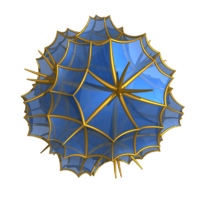 Main cells |
 Cells with extended edges to ideal boundary |
It has a radical subgroup symmetry construction with dodecahedral fundamental domains: Coxeter notation: [4,(3,5)*], index 120.
The order-5 cubic honeycomb has a related alternated honeycomb, ![]()
![]()
![]()
![]()
![]()
![]()
![]() ↔
↔ ![]()
![]()
![]()
![]()
![]() , with icosahedron and tetrahedron cells.
, with icosahedron and tetrahedron cells.
The honeycomb is also one of four regular compact honeycombs in 3D hyperbolic space:
 {5,3,4} |
 {4,3,5} |
 {3,5,3} |
 {5,3,5} |
There are fifteen uniform honeycombs in the [5,3,4] Coxeter group family, including the order-5 cubic honeycomb as the regular form:
| {5,3,4} |
r{5,3,4} |
t{5,3,4} |
rr{5,3,4} |
t0,3{5,3,4} |
tr{5,3,4} |
t0,1,3{5,3,4} |
t0,1,2,3{5,3,4} |
|---|---|---|---|---|---|---|---|

|

|

|

|

|

|

|

|

|

|

|

|

|

|

| |
| {4,3,5} |
r{4,3,5} |
t{4,3,5} |
rr{4,3,5} |
2t{4,3,5} |
tr{4,3,5} |
t0,1,3{4,3,5} |
t0,1,2,3{4,3,5} |
The order-5 cubic honeycomb is in a sequence of regular polychora and honeycombs with icosahedral vertex figures.
| {p,3,5} polytopes | |||||||
|---|---|---|---|---|---|---|---|
| Space | S3 | H3 | |||||
| Form | Finite | Compact | Paracompact | Noncompact | |||
| Name | {3,3,5} |
{4,3,5} |
{5,3,5} |
{6,3,5} |
{7,3,5} |
{8,3,5} |
... {∞,3,5} |
| Image | 
|

|

|

|

|

|

|
| Cells | {3,3} |
{4,3} |
{5,3} |
{6,3} |
{7,3} |
{8,3} |
{∞,3} |
It is also in a sequence of regular polychora and honeycombs with cubic cells. The first polytope in the sequence is the tesseract, and the second is the Euclidean cubic honeycomb.
| {4,3,p} regular honeycombs | |||||||||||
|---|---|---|---|---|---|---|---|---|---|---|---|
| Space | S3 | E3 | H3 | ||||||||
| Form | Finite | Affine | Compact | Paracompact | Noncompact | ||||||
| Name |
{4,3,3} |
{4,3,4} |
{4,3,5} |
{4,3,6} |
{4,3,7} |
{4,3,8} |
... {4,3,∞} | ||||
| Image | 
|

|

|

|

|

|

| ||||
| Vertex figure |
 {3,3} |
 {3,4} |
 {3,5} |
 {3,6} |
 {3,7} |
 {3,8} |
 {3,∞} | ||||
| Rectified order-5 cubic honeycomb | |
|---|---|
| Type | Uniform honeycombs in hyperbolic space |
| Schläfli symbol | r{4,3,5} or 2r{5,3,4} 2r{5,31,1} |
| Coxeter diagram | |
| Cells | r{4,3} {3,5} |
| Faces | triangle {3} square {4} |
| Vertex figure |  pentagonal prism |
| Coxeter group |  , [4,3,5] , [4,3,5] , [5,31,1] , [5,31,1]
|
| Properties | Vertex-transitive, edge-transitive |
The rectified order-5 cubic honeycomb, ![]()
![]()
![]()
![]()
![]()
![]()
![]() , has alternating icosahedron and cuboctahedron cells, with a pentagonal prism vertex figure.
, has alternating icosahedron and cuboctahedron cells, with a pentagonal prism vertex figure.

There are four rectified compact regular honeycombs:
| Image | 
|

|

|

|
|---|---|---|---|---|
| Symbols | r{5,3,4} |
r{4,3,5} |
r{3,5,3} |
r{5,3,5} |
| Vertex figure |

|

|

|

|
| Space | S3 | H3 | ||||
|---|---|---|---|---|---|---|
| Form | Finite | Compact | Paracompact | Noncompact | ||
| Name | r{3,3,5} |
r{4,3,5} |
r{5,3,5} |
r{6,3,5} |
r{7,3,5} |
... r{∞,3,5} |
| Image | 
|

|

|

|
||
| Cells {3,5} |
r{3,3} |
r{4,3} |
r{5,3} |
r{6,3} |
r{7,3} |
r{∞,3} |
| Truncated order-5 cubic honeycomb | |
|---|---|
| Type | Uniform honeycombs in hyperbolic space |
| Schläfli symbol | t{4,3,5} |
| Coxeter diagram | |
| Cells | t{4,3} {3,5} |
| Faces | triangle {3} octagon {8} |
| Vertex figure |  pentagonal pyramid |
| Coxeter group |  , [4,3,5] , [4,3,5]
|
| Properties | Vertex-transitive |
The truncated order-5 cubic honeycomb, ![]()
![]()
![]()
![]()
![]()
![]()
![]() , has truncated cube and icosahedron cells, with a pentagonal pyramid vertex figure.
, has truncated cube and icosahedron cells, with a pentagonal pyramid vertex figure.
It can be seen as analogous to the 2D hyperbolic truncated order-5 square tiling, t{4,5}, with truncated square and pentagonal faces:
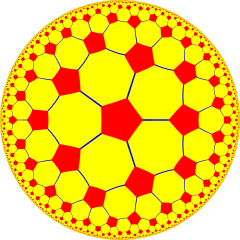
It is similar to the Euclidean (order-4) truncated cubic honeycomb, t{4,3,4}, which has octahedral cells at the truncated vertices.
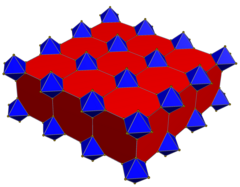
| Image | 
|

|

|

|
|---|---|---|---|---|
| Symbols | t{5,3,4} |
t{4,3,5} |
t{3,5,3} |
t{5,3,5} |
| Vertex figure |

|

|
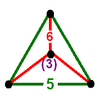
|

|
The bitruncated order-5 cubic honeycomb is the same as the bitruncated order-4 dodecahedral honeycomb.
| Cantellated order-5 cubic honeycomb | |
|---|---|
| Type | Uniform honeycombs in hyperbolic space |
| Schläfli symbol | rr{4,3,5} |
| Coxeter diagram | |
| Cells | rr{4,3} r{3,5} {}x{5} |
| Faces | triangle {3} square {4} pentagon {5} |
| Vertex figure |  wedge |
| Coxeter group |  , [4,3,5] , [4,3,5]
|
| Properties | Vertex-transitive |
The cantellated order-5 cubic honeycomb, ![]()
![]()
![]()
![]()
![]()
![]()
![]() , has rhombicuboctahedron, icosidodecahedron, and pentagonal prism cells, with a wedge vertex figure.
, has rhombicuboctahedron, icosidodecahedron, and pentagonal prism cells, with a wedge vertex figure.
It is similar to the Euclidean (order-4) cantellated cubic honeycomb, rr{4,3,4}:
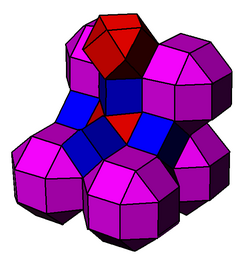
| Four cantellated regular compact honeycombs in H3 | |||||||||||||||
|---|---|---|---|---|---|---|---|---|---|---|---|---|---|---|---|
|
| Cantitruncated order-5 cubic honeycomb | |
|---|---|
| Type | Uniform honeycombs in hyperbolic space |
| Schläfli symbol | tr{4,3,5} |
| Coxeter diagram | |
| Cells | tr{4,3} t{3,5} {}x{5} |
| Faces | square {4} pentagon {5} hexagon {6} octagon {8} |
| Vertex figure |  mirrored sphenoid |
| Coxeter group |  , [4,3,5] , [4,3,5]
|
| Properties | Vertex-transitive |
The cantitruncated order-5 cubic honeycomb, ![]()
![]()
![]()
![]()
![]()
![]()
![]() , has truncated cuboctahedron, truncated icosahedron, and pentagonal prism cells, with a mirrored sphenoid vertex figure.
, has truncated cuboctahedron, truncated icosahedron, and pentagonal prism cells, with a mirrored sphenoid vertex figure.
It is similar to the Euclidean (order-4) cantitruncated cubic honeycomb, tr{4,3,4}:
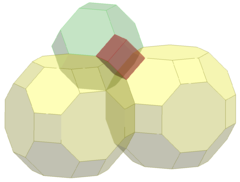
| Image | 
|

|

|

|
|---|---|---|---|---|
| Symbols | tr{5,3,4} |
tr{4,3,5} |
tr{3,5,3} |
tr{5,3,5} |
| Vertex figure |

|

|

|

|
| Runcinated order-5 cubic honeycomb | |
|---|---|
| Type | Uniform honeycombs in hyperbolic space Semiregular honeycomb |
| Schläfli symbol | t0,3{4,3,5} |
| Coxeter diagram | |
| Cells | {4,3} {5,3} {}x{5} |
| Faces | square {4} pentagon {5} |
| Vertex figure |  irregular triangular antiprism |
| Coxeter group |  , [4,3,5] , [4,3,5]
|
| Properties | Vertex-transitive |
The runcinated order-5 cubic honeycomborruncinated order-4 dodecahedral honeycomb ![]()
![]()
![]()
![]()
![]()
![]()
![]() , has cube, dodecahedron, and pentagonal prism cells, with an irregular triangular antiprism vertex figure.
, has cube, dodecahedron, and pentagonal prism cells, with an irregular triangular antiprism vertex figure.
It is analogous to the 2D hyperbolic rhombitetrapentagonal tiling, rr{4,5}, ![]()
![]()
![]()
![]()
![]() with square and pentagonal faces:
with square and pentagonal faces:
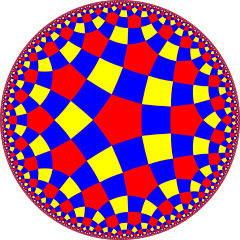
It is similar to the Euclidean (order-4) runcinated cubic honeycomb, t0,3{4,3,4}:
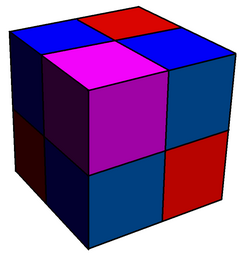
| Image | 
|

|

|
|---|---|---|---|
| Symbols | t0,3{4,3,5} |
t0,3{3,5,3} |
t0,3{5,3,5} |
| Vertex figure |
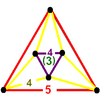
|
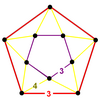
|
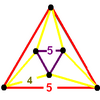
|
| Runctruncated order-5 cubic honeycomb Runcicantellated order-4 dodecahedral honeycomb | |
|---|---|
| Type | Uniform honeycombs in hyperbolic space |
| Schläfli symbol | t0,1,3{4,3,5} |
| Coxeter diagram | |
| Cells | t{4,3} rr{5,3} {}x{5} {}x{8} |
| Faces | triangle {3} square {4} pentagon {5} octagon {8} |
| Vertex figure |  isosceles-trapezoidal pyramid |
| Coxeter group |  , [4,3,5] , [4,3,5]
|
| Properties | Vertex-transitive |
The runcitruncated order-5 cubic honeycomborruncicantellated order-4 dodecahedral honeycomb, ![]()
![]()
![]()
![]()
![]()
![]()
![]() , has truncated cube, rhombicosidodecahedron, pentagonal prism, and octagonal prism cells, with an isosceles-trapezoidal pyramid vertex figure.
, has truncated cube, rhombicosidodecahedron, pentagonal prism, and octagonal prism cells, with an isosceles-trapezoidal pyramid vertex figure.
It is similar to the Euclidean (order-4) runcitruncated cubic honeycomb, t0,1,3{4,3,4}:

| Four runcitruncated regular compact honeycombs in H3 | |||||||||||||||
|---|---|---|---|---|---|---|---|---|---|---|---|---|---|---|---|
|
The runcicantellated order-5 cubic honeycomb is the same as the runcitruncated order-4 dodecahedral honeycomb.
| Omnitruncated order-5 cubic honeycomb | |
|---|---|
| Type | Uniform honeycombs in hyperbolic space Semiregular honeycomb |
| Schläfli symbol | t0,1,2,3{4,3,5} |
| Coxeter diagram | |
| Cells | tr{5,3} tr{4,3} {10}x{} {8}x{} |
| Faces | square {4} hexagon {6} octagon {8} decagon {10} |
| Vertex figure |  irregular tetrahedron |
| Coxeter group |  , [4,3,5] , [4,3,5]
|
| Properties | Vertex-transitive |
The omnitruncated order-5 cubic honeycomboromnitruncated order-4 dodecahedral honeycomb, ![]()
![]()
![]()
![]()
![]()
![]()
![]() , has truncated icosidodecahedron, truncated cuboctahedron, decagonal prism, and octagonal prism cells, with an irregular tetrahedral vertex figure.
, has truncated icosidodecahedron, truncated cuboctahedron, decagonal prism, and octagonal prism cells, with an irregular tetrahedral vertex figure.
It is similar to the Euclidean (order-4) omnitruncated cubic honeycomb, t0,1,2,3{4,3,4}:

| Three omnitruncated regular compact honeycombs in H3 | ||||||||||||
|---|---|---|---|---|---|---|---|---|---|---|---|---|
|
| Alternated order-5 cubic honeycomb | |
|---|---|
| Type | Uniform honeycombs in hyperbolic space |
| Schläfli symbol | h{4,3,5} |
| Coxeter diagram | |
| Cells | {3,3} {3,5} |
| Faces | triangle {3} |
| Vertex figure |  icosidodecahedron |
| Coxeter group |  , [5,31,1] , [5,31,1]
|
| Properties | Vertex-transitive, edge-transitive, quasiregular |
In 3-dimensional hyperbolic geometry, the alternated order-5 cubic honeycomb is a uniform compact space-filling tessellation (orhoneycomb). With Schläfli symbol h{4,3,5}, it can be considered a quasiregular honeycomb, alternating icosahedra and tetrahedra around each vertex in an icosidodecahedron vertex figure.
It has 3 related forms: the cantic order-5 cubic honeycomb, ![]()
![]()
![]()
![]()
![]()
![]()
![]() , the runcic order-5 cubic honeycomb,
, the runcic order-5 cubic honeycomb, ![]()
![]()
![]()
![]()
![]()
![]()
![]() , and the runcicantic order-5 cubic honeycomb,
, and the runcicantic order-5 cubic honeycomb, ![]()
![]()
![]()
![]()
![]()
![]()
![]() .
.
| Cantic order-5 cubic honeycomb | |
|---|---|
| Type | Uniform honeycombs in hyperbolic space |
| Schläfli symbol | h2{4,3,5} |
| Coxeter diagram | |
| Cells | r{5,3} t{3,5} t{3,3} |
| Faces | triangle {3} pentagon {5} hexagon {6} |
| Vertex figure |  rectangular pyramid |
| Coxeter group |  , [5,31,1] , [5,31,1]
|
| Properties | Vertex-transitive |
The cantic order-5 cubic honeycomb is a uniform compact space-filling tessellation (orhoneycomb), with Schläfli symbolh2{4,3,5}. It has icosidodecahedron, truncated icosahedron, and truncated tetrahedron cells, with a rectangular pyramid vertex figure.
| Runcic order-5 cubic honeycomb | |
|---|---|
| Type | Uniform honeycombs in hyperbolic space |
| Schläfli symbol | h3{4,3,5} |
| Coxeter diagram | |
| Cells | {5,3} rr{5,3} {3,3} |
| Faces | triangle {3} square {4} pentagon {5} |
| Vertex figure |  triangular frustum |
| Coxeter group |  , [5,31,1] , [5,31,1]
|
| Properties | Vertex-transitive |
The runcic order-5 cubic honeycomb is a uniform compact space-filling tessellation (orhoneycomb), with Schläfli symbolh3{4,3,5}. It has dodecahedron, rhombicosidodecahedron, and tetrahedron cells, with a triangular frustum vertex figure.
| Runcicantic order-5 cubic honeycomb | |
|---|---|
| Type | Uniform honeycombs in hyperbolic space |
| Schläfli symbol | h2,3{4,3,5} |
| Coxeter diagram | |
| Cells | t{5,3} tr{5,3} t{3,3} |
| Faces | triangle {3} square {4} hexagon {6} decagon {10} |
| Vertex figure |  irregular tetrahedron |
| Coxeter group |  , [5,31,1] , [5,31,1]
|
| Properties | Vertex-transitive |
The runcicantic order-5 cubic honeycomb is a uniform compact space-filling tessellation (orhoneycomb), with Schläfli symbolh2,3{4,3,5}. It has truncated dodecahedron, truncated icosidodecahedron, and truncated tetrahedron cells, with an irregular tetrahedron vertex figure.